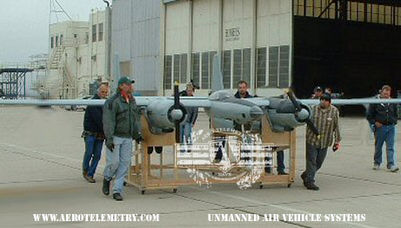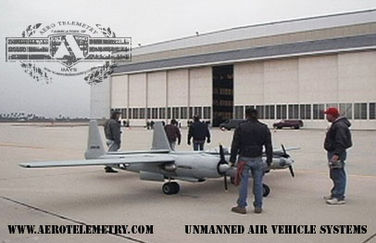

HUGHES XF-11
AVIATOR HUGHES XF-11
Completing the Hughes XF-11 airplane in 3 months proved to be one of the biggest challenges for the Aero Telemetry team. Joe Bok and his team had to design a custom set of landing gear, fabricate an ultra-strong airframe, coordinate a complex flight control system, test counter-rotating engines, and integrate all of these systems seamlessly to overcome the aerodynamic stresses of high speed and heavy payload.

Photo courtesy of Miramax Films
HISTORY OF THE HUGHES XF-11
Howard Hughes XF-11 was a prototype reconnaissance aircraft made for the US military. On July 7,1946 Hughes himself piloted the plane on its maiden flight. After being airborne for over two hours, the starboard propellor began to fail and made the XF-11 pull violently to the right. Hughes did all he could to save the crippled plane but, unfortunately ended up crashing and taking out three homes in the process. The plane was destroyed and the crash nearly killed Howard Hughes.
THE HUGHES XF-11 DESIGN & BUILD
The Aviator XF-11 replica designed and built by Aero Telemetry had a wingspan of 25 ft. Because of its size and weight the model performed exactly as a full-size aircraft would and provided the cameras with spectacular, stunning, and realistic flight sequences.
To counteract any unexpected flight behavior or tendency for The Aviator XF-11 to yaw (move right or left) because of gyroscopic precession, Joe Bok designed the airplane to have each of the engines and propellers turn opposite each other to cancel out the energy created by the rotating propellers.
The original XF-11, designed by Howard Hughes and his talented engineering staff, incorporated several ingenious designs to allow the airplane to exceed it's original mission profile. Like Howard Hughes and his team, Joe and his engineering staff incorporated several ingenious designs into their version of the XF-11.
The aerodynamic profile of the wing, engine thrust-lines, CG location, main airfoil angle of attack, incidence angles (between wing and horizontal stabilizer), counter-rotating propellers, and vertical stabilizer offset angles were just a few of the critical design criteria addressed and implemented correctly by the Aero Telemetry engineering design team. All these specific details contributed directly to the success and margin of safety exemplified in all the flights of the Aero Telemetry XF-11.
XF-11 LANDING GEAR
Custom hydraulic landing gear were designed and fabricated for the 1/4 scale XF-11. Due to the compressed schedule, the gear had to designed, tested, and installed during an incredibly short time-frame. There was no room for errors.
XF-11 ENGINE TESTING
The XF-11 was powered by two twin cylinder air-cooled 2-stroke engines modified to 273cc. The starboard engine was additionally modified to turn in the opposite direction than the port engine. This gave the model additional stability about the Yaw axis. Hours of testing each engine by the Aero Telemetry team helped make sure the engines would be operating at maximum power output during the flights. The engines used fixed-pitch, counter-rotating propellers provided by the Tennessee Propeller Company.
XF-11 FLIGHTS
Click here to see the video of our XF-11 model in flight.
The Aviator XF-11, like the H-1 Racer built by Aero Telemetry, was flown at two separate locations. The first would be at the San Bernardino Airport on November 21, 2003, the second was almost 3 months later on February 29, 2004 at Catalina Island 26 miles off the coast of California.
The San Bernardino Airport was previously known as Norton Air Force Base. The base was named after a US Army Air Force Captain Leland Francis Norton who was killed during a mission in World War Two. The airport and has an awesome 10,000 main runway that was once used by huge US Air Force C-141 transport planes.
The Hughes XF-11 replica was set-up in a monstrous hanger that was decorated to resemble a Hughes Aircraft Hanger from the 1940's. The Aero Telemetry aerial effects team worked through the night and into the next day to have the huge model ready for its history making flight attempt.
Although the XF-11 flew twice that day, it was a grey overcast sky that prevented any of that footage from being used in the film sequences.
For the second set of flights, the XF-11 would be flown at Catalina Island on February 29, 2004. The island is remote and provided excellent backdrops for both aerial and ground based film cameras. The Catalina Airport, also known as the "Airport in the Sky", is located at the island's highest elevation of 1,602 ft. The higher altitude however required the XF-11 to have as much power as possible to climb out under full load at higher than normal density altitudes.
The Aviator XF-11 was piloted by two FAA licensed pilots, Billy Hemple and Joe Bok. Billy and Joe, acting as co-pilot, flew the XF-11 at both Norton AFB and the Catalina Island Airport flight locations.
As a fitting testimony to how amazing the Aero Telemetry flyable models really were, shots of our XF-11 flying were featured in the theatrical and television trailers for the movie The Aviator, in addition to making it into the behind the scenes film, "A Life Without Limits, The Making of The Aviator"
Click the images below to read articles written about Aero Telemetry's XF-11:
SPECIFICATIONS
DIMENSIONS:
WINGSPAN: 25 ft
LENGTH: 16.25 ft
WEIGHT: 550 lbs with fuel
ENGINES: Two 273cc twin-cylinder air-cooled 2 strokes. Starboard engine modified to turn opposite of Port engine - counter clockwise
PROPELLERS: Tennessee Propeller Fixed Pitch, 2 blade LH & RH wood propellers
PERFORMANCE:
SPEED: Up to 125 mph
ALTITUDE: Up to 10,000 ft
RANGE: Up to 10 miles radio range with approximately 20 minutes of fuel
ACTING ABILITY:
The plane was flown several times at both San Bernardino Airport and Catalina Island Airport in California. During the flights, the Hughes XF-11 was filmed by a manned Jet Ranger III helicopter equipped with a gyro-stabilized film camera. As a fitting testament to how amazing the footage really was, shots of the XF-11 flying were used both in the Television trailers for The Aviator movie and the film sequence used to introduce the movie at the 77th Academy Awards ceremony. Due to its size, speed and excellent flying characteristics, the Aero Telemetry XF-11 airplane made the flying sequences simply spectacular! The background at Catalina Island provided a historically accurate picture of the way the Los Angeles area looked during the 1940's















































.jpg)